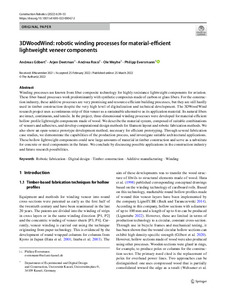3DWoodWind: robotic winding processes for material-efficient lightweight veneer components
| dc.date.accessioned | 2022-08-16T09:24:52Z | |
| dc.date.available | 2022-08-16T09:24:52Z | |
| dc.date.issued | 2022-03-25 | |
| dc.identifier | doi:10.17170/kobra-202206016278 | |
| dc.identifier.uri | http://hdl.handle.net/123456789/14058 | |
| dc.description.sponsorship | Gefördert im Rahmen des Projekts DEAL | ger |
| dc.language.iso | eng | |
| dc.rights | Namensnennung 4.0 International | * |
| dc.rights.uri | http://creativecommons.org/licenses/by/4.0/ | * |
| dc.subject | robotic fabrication | eng |
| dc.subject | digital design | eng |
| dc.subject | timber construction | eng |
| dc.subject | additive manufacturing | eng |
| dc.subject | winding | eng |
| dc.subject.ddc | 004 | |
| dc.subject.ddc | 600 | |
| dc.title | 3DWoodWind: robotic winding processes for material-efficient lightweight veneer components | eng |
| dc.type | Aufsatz | |
| dcterms.abstract | Winding processes are known from fiber composite technology for highly resistance lightweight components for aviation. These fiber-based processes work predominantly with synthetic composites made of carbon or glass fibers. For the construction industry, these additive processes are very promising and resource-efficient building processes, but they are still hardly used in timber construction despite the very high level of digitalization and technical development. The 3DWoodWind research project uses a continuous strip of thin veneer as a sustainable alternative as its application material. Its natural fibers are intact, continuous, and tensile. In the project, three-dimensional winding processes were developed for material-efficient hollow profile lightweight components made of wood. We describe the material system, composed of suitable combinations of veneers and adhesives, and develop computational design methods for filament layout and robotic fabrication methods. We also show an open-source prototype development method, necessary for efficient prototyping. Through several fabrication case studies, we demonstrate the capabilities of the production process, and investigate suitable architectural applications. These hollow lightweight components could save large amounts of material in timber construction and serve as a substitute for concrete or steel components in the future. We conclude by discussing possible applications in the construction industry and future research possibilities. | eng |
| dcterms.accessRights | open access | |
| dcterms.creator | Göbert, Andreas | |
| dcterms.creator | Deetman, Arjen | |
| dcterms.creator | Rossi, Andrea | |
| dcterms.creator | Weyhe, Ole | |
| dcterms.creator | Eversmann, Philipp | |
| dc.relation.doi | doi:10.1007/s41693-022-00067-2 | |
| dc.subject.swd | Holzindustrie | ger |
| dc.subject.swd | Effizienz | ger |
| dc.subject.swd | Nachhaltigkeit | ger |
| dc.subject.swd | Robotik | ger |
| dc.subject.swd | 3D-Technologie | ger |
| dc.type.version | publishedVersion | |
| dcterms.source.identifier | eissn:2509-8780 | ger |
| dcterms.source.issue | Issue 1 | |
| dcterms.source.journal | Construction Robotics | eng |
| dcterms.source.pageinfo | 39-55 | |
| dcterms.source.volume | Volume 6 | |
| kup.iskup | false |
Dateien zu dieser Ressource
Das Dokument erscheint in:
-
Artikel [1103]


